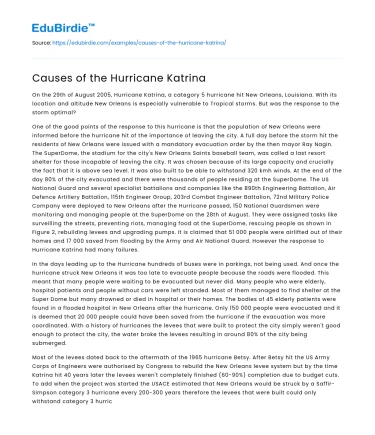On the 29th of August 2005, Hurricane Katrina, a category 5 hurricane hit New Orleans, Louisiana. With its location and altitude New Orleans is especially vulnerable to Tropical storms. But was the response to the storm optimal?
One of the good points of the response to this hurricane is that the population of New Orleans were informed before the hurricane hit of the importance of leaving the city. A full day before the storm hit the residents of New Orleans were issued with a mandatory evacuation order by the then mayor Ray Nagin. The SuperDome, the stadium for the city's New Orleans Saints baseball team, was called a last resort shelter for those incapable of leaving the city. It was chosen because of its large capacity and crucially the fact that it is above sea level. It was also built to be able to withstand 320 kmh winds. At the end of the day 80% of the city evacuated and there were thousands of people residing at the SuperDome. The US National Guard and several specialist battalions and companies like the 890th Engineering Battalion, Air Defence Artillery Battalion, 115th Engineer Group, 203rd Combat Engineer Battalion, 72nd Military Police Company were deployed to New Orleans after the Hurricane passed, 150 National Guardsmen were monitoring and managing people at the SuperDome on the 28th of August. They were assigned tasks like surveilling the streets, preventing riots, managing food at the SuperDome, rescuing people as shown in Figure 2, rebuilding levees and upgrading pumps. It is claimed that 51 000 people were airlifted out of their homes and 17 000 saved from flooding by the Army and Air National Guard. However the response to Hurricane Katrina had many failures.
Save your time!
We can take care of your essay
- Proper editing and formatting
- Free revision, title page, and bibliography
- Flexible prices and money-back guarantee
In the days leading up to the Hurricane hundreds of buses were in parkings, not being used. And once the hurricane struck New Orleans it was too late to evacuate people because the roads were flooded. This meant that many people were waiting to be evacuated but never did. Many people who were elderly, hospital patients and people without cars were left stranded. Most of them managed to find shelter at the Super Dome but many drowned or died in hospital or their homes. The bodies of 45 elderly patients were found in a flooded hospital in New Orleans after the hurricane. Only 150 000 people were evacuated and it is deemed that 20 000 people could have been saved from the hurricane if the evacuation was more coordinated. With a history of hurricanes the levees that were built to protect the city simply weren't good enough to protect the city, the water broke the levees resulting in around 80% of the city being submerged.
Most of the levees dated back to the aftermath of the 1965 hurricane Betsy. After Betsy hit the US Army Corps of Engineers were authorised by Congress to rebuild the New Orleans levee system but by the time Katrina hit 40 years later the levees weren't completely finished (60-90%) completion due to budget cuts. To add when the project was started the USACE estimated that New Orleans would be struck by a Saffir-Simpson category 3 hurricane every 200-300 years therefore the levees that were built could only withstand category 3 hurricanes. This estimation was extremely inaccurate considering New Orleans hurricane history and how it is exposed to hurricanes. The GAO (US Government Accountability Office) found that the US Government and the USACE were at least partially responsible for the destruction and the flooding. FEMA (The Federal Emergency Management Agency) also refused help from many organisations such as the Red Cross and different police forces until they were strictly necessary claiming that the Army could manage the response on its own. In the end FEMA were the major reason why the response to the Hurricane was largely slow and ineffective. After the Hurricane the then director of FEMA Michael Brown stepped down from his position. In Figure 1 (although unrelated to Katrina because it Is a picture of the rebuilding of a house after super-typhoon Haiyan in the Philippines in 2013) we see a house being rebuilt, but in the case of New Orleans only the wealthiest parts of the city got that treatment, many parts of New Orleans are still derelict and the few poor areas that were rebuilt weren't upgraded which means that they are still drastically inferior to accommodation in other parts of the city.
To conclude, Hurricane Katrina revealed the incompetence of the US Government and many agencies including FEMA , DOT (Department of Transport) and the Army to deal with a large natural disaster. Many New Orleanians still feel left out to this day as the city wasn't given a proper amount of aid to build back this is proven by the fact that now, 15 years after the Hurricane New Orleans is still suffering. The response to Hurricane Katrina is deemed by many as an example of one of the worst responses to a disaster in recent history especially for a country with the means of the US and an overwhelming failure.
Did you like this example?
Make sure you submit a unique essay
Our writers will provide you with an essay sample written from scratch: any topic, any deadline, any instructions.
Cite this paper
-
APA
-
MLA
-
Harvard
-
Vancouver
Causes of the Hurricane Katrina.
(2022, September 15). Edubirdie. Retrieved December 22, 2024, from https://edubirdie.com/examples/causes-of-the-hurricane-katrina/
“Causes of the Hurricane Katrina.” Edubirdie, 15 Sept. 2022, edubirdie.com/examples/causes-of-the-hurricane-katrina/
Causes of the Hurricane Katrina. [online].
Available at: <https://edubirdie.com/examples/causes-of-the-hurricane-katrina/> [Accessed 22 Dec. 2024].
Causes of the Hurricane Katrina [Internet]. Edubirdie.
2022 Sept 15 [cited 2024 Dec 22].
Available from: https://edubirdie.com/examples/causes-of-the-hurricane-katrina/
copy






 Stuck on your essay?
Stuck on your essay?

